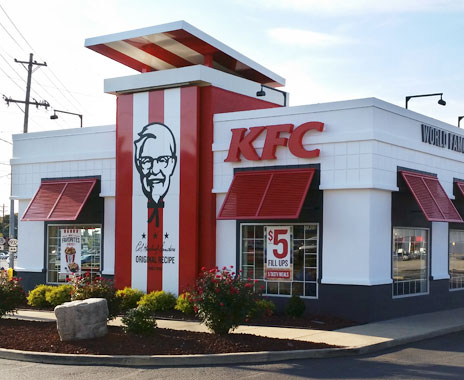Images of the late Col. Harlan Sanders are everywhere as you walk through the Louisville, Kentucky, headquarters of KFC and its parent, Yum! Brands. Not only are there plenty of photos and videos of the company founder and creator of the world’s most popular fried chicken recipe, but there are also statues of him both standing and sitting, as well as an animatronic version in the onsite Col. Sanders Museum.
A stylized version of Sanders visage—including Van Dyke beard, Western-style bowtie, and white suit—is part of KFC’s logo, and he remains one of America’s best-known commercial faces even though he died nearly a quarter-century ago. And soon the honorary Kentucky colonel’s Southern drawl might even make its way back into America’s consciousness; KFC is readying special marketing efforts to celebrate the 75th anniversary of the final incarnation of the Kentucky Fried Chicken recipe.
“We’re working on an ad campaign that will bring back his voice,” Kevin Hochman, chief marketing officer for KFC U.S., says during a recent tour of the company’s offices and kitchens. Consumers can also expect to see “lots of innovative surprises for the 75th anniversary,” he says. Hochman declines to go beyond those teasers. In the past, KFC has employed actors to portray Sanders’ voice in advertising.
Innovation at KFC, at least in the public consciousness, has taken something of a back seat in recent years to Yum’s two other brands, Pizza Hut and particularly Taco Bell, which has launched a breakfast menu and had hits with several menu items, such as Doritos Locos Tacos. But KFC hasn’t been sitting still, with new product introductions like boneless and bite-sized chicken, as well as the Go Cup, a container that fits in vehicle cup holders and includes a choice of chicken with potato wedges.
The company also has looked at different store designs and styles. It opened a fast-casual concept, KFC Eleven, in 2013 in its hometown and is testing a new, fresher design—rife with Sanders photos and memorabilia—at a unit in another part of the city.
KFC has seen huge growth outside the U.S.—two-thirds of its locations are international, and China is its largest single market. In Japan, going to KFC is a Christmas tradition and sometimes requires making a reservation. Back at home, however, the chain has lost its crown as America’s biggest chicken chain to Chick-fil-A. In 2013, KFC did $4.3 billion in U.S. sales, while Chick-fil-A raked in around $5 billion domestically.
Through it all, executives said during the headquarters tour, KFC continues to focus on the quality of its chicken. That includes its famous recipe of 11 herbs and spices, the formula of which is held in a large vault built into a white wall in a nondescript office at the headquarters. There’s another vault inside the vault, protected by two feet of concrete and various electronic security devices.
The recipe kept inside “is more than the actual ingredients,” says Rodrigo Coronel, public relations manager. “It’s how you blend it,” he adds, noting that two companies make different parts of the blend.
In recent years, some of the chain’s advertising homed in on the fried chicken and how it’s made. Corporate team members were only too excited to demonstrate the process during the tour, walking through test kitchens, conducting consumer taste tests, and preparing and cooking fried chicken and chicken strips.
The test kitchen “is where we do a lot of innovation work,” says Bob Das, Yum’s chief corporate chef. It’s also where KFC does considerable work with vendors, franchisees, and corporate team members to develop new equipment and products. Consumers will see that, Das says, “with lunch and ideas around lunch.”
The KFC testing area typically hosts two or three taste tests every week, drawing from a pool of about 25,000 local residents who are chosen for their particular demographics and whether they are heavy users of particular menu items. The company also has a trained panel of 10 “super tasters.” The panel members, all women, were screened for their tasting expertise and are then trained further.
“What we’ve found is consumers are very good at telling us what they like, such as sweetness or crunch,” says Vanessa Calvert, sensory coordinator for KFC. For the super tasters, “it’s all about telling the difference, because we’re approving suppliers, we’re approving equipment, holding shelf life studies.”
As for making KFC’s chicken, it’s a very specific process, one that company officials expect to be replicated at restaurants all over the world, says Mike Showalter, research and development chef. Fresh chicken—which arrives at the stores in bags that contain the breasts, thighs, legs, and wings of two chickens—is inspected for issues like deep bruises in the meat of if any feathers are still attached. Small dark objects are removed from the back of the thigh.
The next step is breading. The chicken pieces are placed in a metal basket, dipped in water, taken out, and shifted from side to side seven times to remove the liquid. They then goes into a large plastic container filled with the coating—flour, milk powder, eggs, and the secret herb-and-spice concoction—and manipulated through the silky soft mixture seven times.
“It’s like putting your hands in a cloud,” Coronel says.
The breaded chicken is placed on a metal grate in a specific fashion so all the pieces fit. Grates with the pieces of eight chickens go into large pressure-cooking machine—unlike the small pressure pot originally used—and cook for more than 15 minutes.
“The temperature fluctuates in the pressure cooker to create the perfect moisture and texture,” Das says. The final product is a golden brown color.
It’s this kind of quality, consistency, and transparency that KFC hopes will help it restore its position within the public consciousness—and make the Colonel proud.








